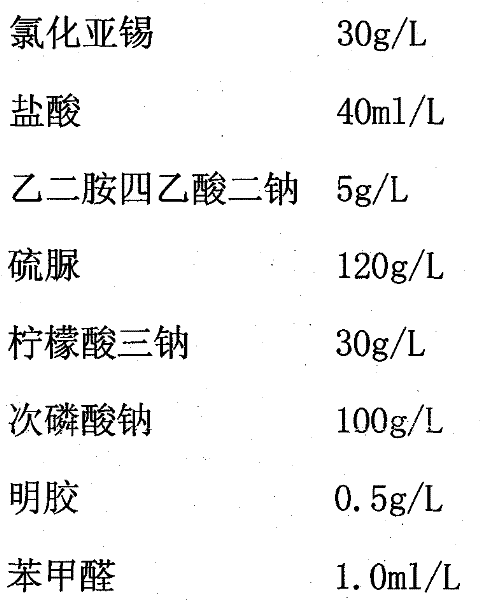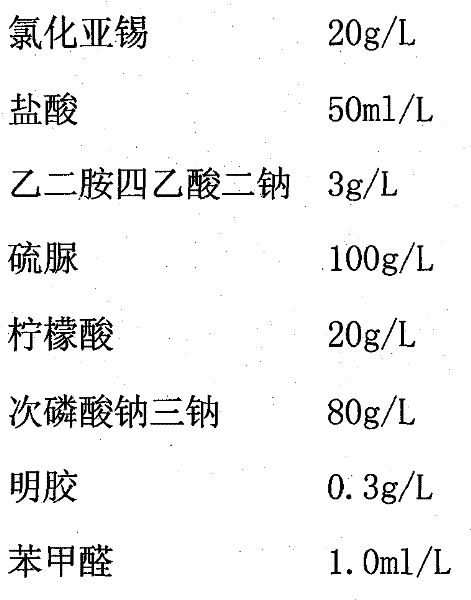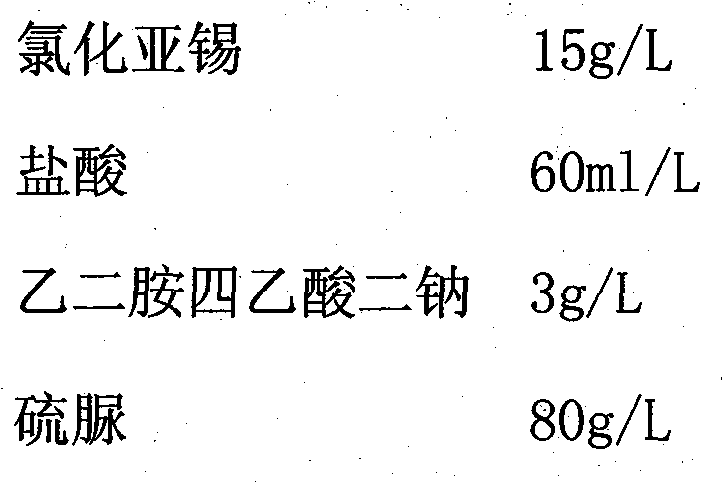Continuously self-catalyzed deposition chemical plating solution of tin and using method thereof
An electroless plating solution and self-catalysis technology, applied in the field of electroless plating, can solve the problems of inability to realize continuous self-catalytic deposition of tin, low deposition rate of electroless tin plating, failure to obtain industrial application, etc., and achieve high batch production stability, The effect of fast deposition rate and porosity reduction
- Summary
- Abstract
- Description
- Claims
- Application Information
AI Technical Summary
Problems solved by technology
Method used
Image
Examples
Embodiment 1
[0025] The formula of electroless tin plating solution is:
[0026]
[0027] The process conditions of the electroless tin plating solution are: the temperature of the plating solution is 88±2°C, the pH value is 2.0, the electroless plating time is 3 hours, and the loading capacity of the plating solution is 1.2dm 2 / L.
[0028] The thickness of the electroless coating obtained in Example 1 is 31.4 μm, the appearance is silver-white-semi-bright, the tin content is 95.8wt%, and the porosity is lower than 4 pieces / 6cm 2 . In a tin-lead alloy in which the flux is 25% rosin isopropanol and the solder is 60% tin + 40% lead, the wetting time is less than 2s, and the solderability is good. After passivation treatment, the appearance and color of the coating will not change after being placed in the air for 3 months. The passivation process is: K 2 Cr 2 o 7 2H 2 O: 15g / L, KOH: 5-8g / L, (NH 4 ) 6 Mo 7 o 24 4H 2 O: 15~18g / L, T: room temperature, time: 10~15min.
Embodiment 2
[0030] The formula of electroless tin plating solution is:
[0031]
[0032] The process conditions of the electroless tin plating solution are: the temperature of the plating solution is 88±2°C, the pH value is 1.5, the electroless plating time is 3 hours, and the loading capacity of the plating solution is 1.2dm 2 / L.
[0033] The thickness of the electroless coating obtained in Example 2 is 25.5 μm, the appearance is silver-white-semi-bright, the tin content is 93.6wt%, and the porosity is lower than 4 pieces / 6cm 2 . In a tin-lead alloy in which the flux is 25% rosin isopropanol and the solder is 60% tin + 40% lead, the wetting time is less than 2s, and the solderability is good. After passivation treatment, the appearance and color of the coating remain unchanged after being placed in the air for 3 months.
Embodiment 3
[0035] The formula of electroless tin plating solution is:
[0036]
[0037]
[0038] The process conditions of the electroless tin plating solution are: the temperature of the plating solution is 88±2°C, the pH value is 1.0, the electroless plating time is 3 hours, and the loading capacity of the plating solution is 1.2dm 2 / L.
[0039] The thickness of the electroless coating obtained in Example 3 is 21.2 μm, the appearance is silvery white, the tin content is 92.8wt%, and the porosity is lower than 4 pieces / 6cm 2 . In a tin-lead alloy in which the flux is 25% rosin isopropanol and the solder is 60% tin + 40% lead, the wetting time is less than 2s, and the solderability is good. After passivation treatment, after 3 months in the air, the appearance and color of the electroless tin plating layer have no change.
PUM
| Property | Measurement | Unit |
|---|---|---|
| thickness | aaaaa | aaaaa |
| thickness | aaaaa | aaaaa |
| thickness | aaaaa | aaaaa |
Abstract
Description
Claims
Application Information
 Login to View More
Login to View More - R&D
- Intellectual Property
- Life Sciences
- Materials
- Tech Scout
- Unparalleled Data Quality
- Higher Quality Content
- 60% Fewer Hallucinations
Browse by: Latest US Patents, China's latest patents, Technical Efficacy Thesaurus, Application Domain, Technology Topic, Popular Technical Reports.
© 2025 PatSnap. All rights reserved.Legal|Privacy policy|Modern Slavery Act Transparency Statement|Sitemap|About US| Contact US: help@patsnap.com



